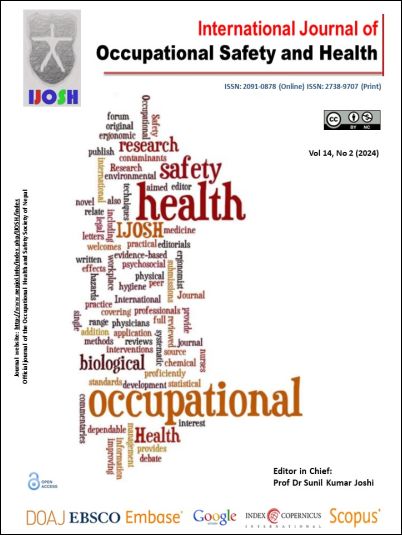Major Hazard Competent Person Profession in Malaysia: A document analysis of trends and demands
DOI:
https://doi.org/10.3126/ijosh.v14i2.52503Keywords:
CIMAH, Competency, Major Hazard installation, OSH profession, OYK Major HazardAbstract
Introduction: The Malaysian Control of Industrial Major Accident Hazard (CIMAH) Regulations introduced in 1996 resulted in the creation ‘Major Hazard Competent Person’ (MHCP) profession. However, after two decades of its establishment, there has been limited study conducted on this specific profession. The objectives of this study are to analyze 1) the trend of application and passing rates of MHCP registrations; and 2) the trend of Major Hazard Installations (MHI) registrations, and its relationship with the available supply of registered MHCP.
Methods: The study used a document review approach, involving the extraction, examination, and interpretation of data from both published and unpublished documents by the Department of Occupational Safety and Health (DOSH), the regulatory body responsible for overseeing both MHCP and MHI registration status in Malaysia. The study looks into data from 1996 (beginning of 1996 CIMAH Regulation) to 2023, though the available data found and analyzed were from 1998 to 2021.
Results: The study reveals a concerning lack of growth in the number of professionals being certified as MHCP, despite an increase in the number of MHIs over the past two decades. Potential causes of this shortage identified include a demanding certification process, limited availability of MHCP competency courses, and a lack of clear career paths and growth opportunities in the profession.
Conclusion: The inadequate supply of MHCPs could potentially undermine their ability to provide sufficient coverage for MHIs, indirectly jeopardizing the quality of risk management in major hazard facilities. Therefore, there is merit in periodically reviewing the regulations and reforming the MHCP profession in response to changing trends.
Downloads
Downloads
Published
How to Cite
Issue
Section
License
Copyright (c) 2024 The Author(s)

This work is licensed under a Creative Commons Attribution-NonCommercial 4.0 International License.
This license enables reusers to distribute, remix, adapt, and build upon the material in any medium or format for noncommercial purposes only, and only so long as attribution is given to the creator.





